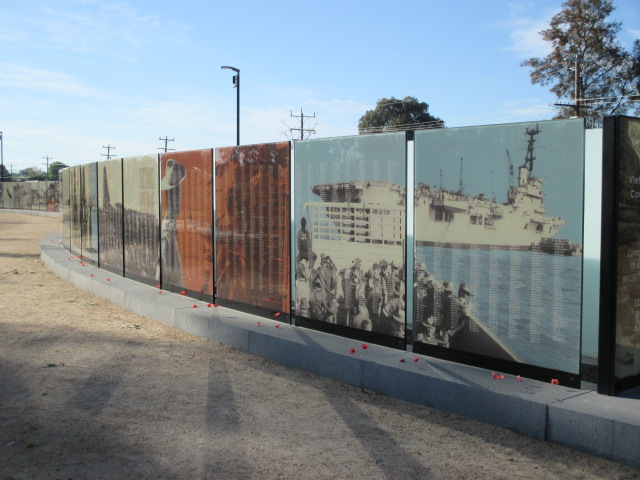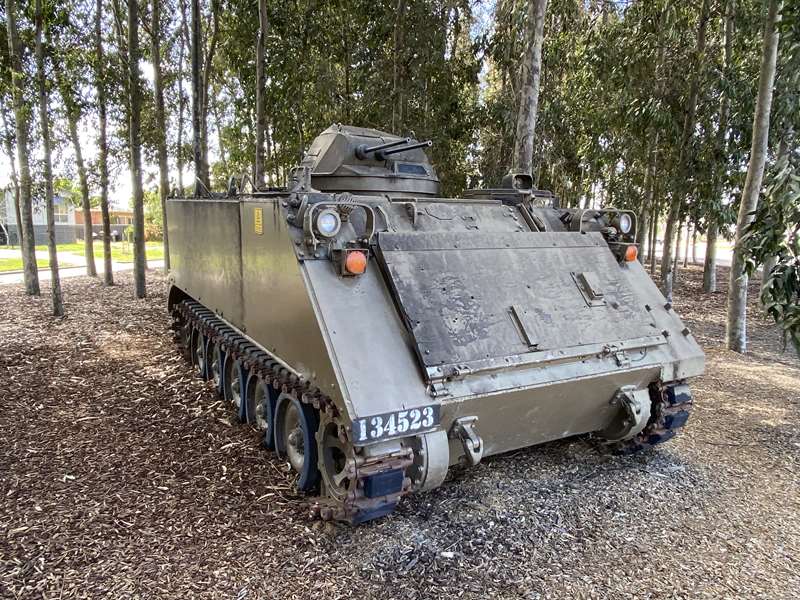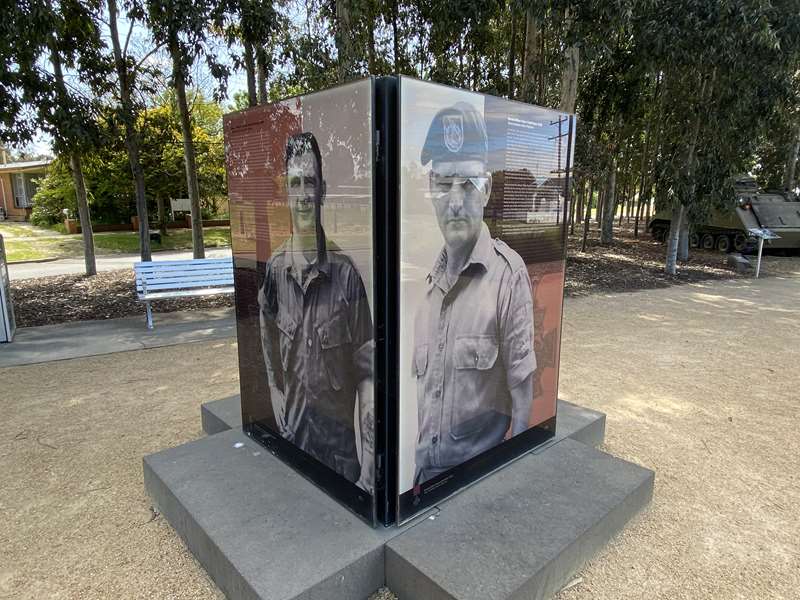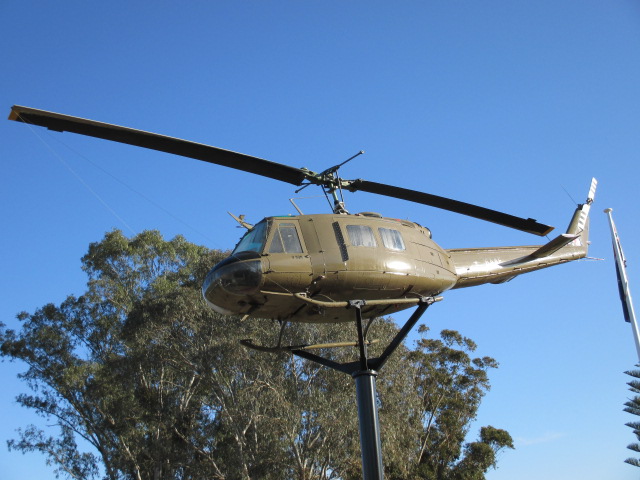Seymour - Vietnam Veterans Commemorative Walk


The Vietnam Veterans Commemorative Walk is the only one of its kind in Australia dedicated to Vietnam Veterans. The Walk has been created using symbolic elements of Vietnam and over 60,000 names of every serviceman and servicewoman who served in the conflict are listed.
The Commemorative Walk commemorates the service of all who played their part in what turned out to be a tumultuous part of Australia's history. It does, in the interpretive centre, give an accurate history of the times prior to military commitment, the period of our involvement and the aftermath.
The Walk is a meandering red earth path set in native trees and grasses that resemble rubber trees and rice paddies. These two plants are synonymous with Vietnam.
The centre piece of this Walk is the wall, made up of panels of DigiGlass with the name of every Serviceman and Woman who served, in their various capacities in that conflict. The names are separated only by the Service in which they served and are in alphabetical order. The plinths on which the panels stand have holes for you to place Poppies; the effect is to have a field of Poppies under the names. Behind the names is the picture story of the Vietnam conflict.
By all means find the names of loved ones by standing close to the Wall, but also draw back 5 or so metres and look at the pictures behind the names. There is the story of Vietnam in photos, mainly supplied by Veterans.
There are areas of contemplation for people to use along the length of this walk.

There are real parts of history with a Centurion tank, a Huey helicopter, artillery pieces and an M1A1 APC. There are also places to just sit and peacefully reflect.

At the end of the wall there is a cube with panels celebrating four people:
Warrant Officer Class II Rayene Stewart Simpson D.C.M. 217622
Royal Australian Infantry
On 6th May 1969, Warrant Officer Simpson was serving as Commander of 232nd Mobile Strike Force Company of 5th Special Forces Group on a search and clear operation in Kontum Province, near the Laotion border. When one of his platoons became heavily engaged with the enemy, he led the remainder of his company to its assistance. Disregarding the dangers involved, he placed himself at the front of his troops, thus becoming a focal point of enemy fire, and personally led the assault on the left flank of the enemy position. As the company moved forward, an Australian Warrant Officer commanding one of the platoons was seriously wounded and the assault began to falter. Warrant Officer Simpson, at great personal risk and under heavy enemy fire, moved across open ground, reached the wounded Warrant Officer and carried him to a position of safety. He then returned to his company where, with complete disregard for his safety, he crawled forward to within ten metres of the enemy and threw grenades into their positions. As darkness fell, and being unable to break into the enemy position, Warrant Officer Simpson ordered his company to withdraw. He then threw smoke-grenades and, carrying a wounded platoon leader, covered the withdrawal of the company together with five indigenous soldiers. His leadership and personal bravery in this action were outstanding.
On 11th-May 1969, in the same operation, Warrant Officer Simpson's Battalion Commander was killed and an Australian Warrant Officer and several indigenous soldiers were wounded. In addition, one other Australian Warrant Officer who had been separated from the majority of his troops was contained in the area by enemy fire. Warrant Officer Simpson quickly organised two platoons of indigenous soldiers and several advisors and led them to the position of the contact. On reaching the position the element with Warrant Officer Simpson came under heavy fire and all but a few of the soldiers with him fell back. Disregarding his own safety, he moved forward in the face of accurate enemy machine gun fire, in order to cover the initial evacuation of the casualties. The wounded were eventually moved out of the line of enemy fire, which all this time was directed at Warrant Officer Simpson from close range. At the risk of almost certain death he made several attempts to move further forward towards his Battalion Commander's body but on each occasion he was stopped by heavy fire. Realising the position was becoming untenable and that priority should be given to extricating other casualties as quickly as possible, Warrant Officer Simpson alone and still under enemy fire covered the withdrawal of the wounded by personally placing himself between the wounded and the enemy. From this position he fought on and by outstanding courage and valour was able to prevent the enemy advance until the wounded were removed from the immediate vicinity. Warrant Officer Simpson's gallant and individual action and his coolness under fire were exceptional and were instrumental in achieving the successful evacuation of the wounded to the helicopter evacuation pad.
Warrant Officer Simpson's repeated acts of personal bravery in this operation were an inspiration to all Vietnamese, United States and Australian soldiers who served with him. His conspicuous gallantry was in the highest tradition of the Australian Army.
Warrant Officer Class Keith Payne 12222
Royal Australian Infantry Regiment
On 24th May 1969, in Kontum Province, Warrant Officer Payne was Commanding 212th Company of 1st Mobile Strike Force Battalion when the battalion was attacked by a North Vietnamese force of superior strength. The enemy isolated the two leading companies, one of which was Warrant Officer Payne's, and with heavy mortar and rocket support assaulted their position from three directions simultaneously. Under this heavy attack the indigenous soldiers began to fall back. Directly exposing himself to the enemy's fire, Warrant Officer Payne, through his own efforts, temporarily held off the assaults by alternately firing his weapon and running from position to position collecting grenades and throwing them at the assaulting enemy. While doing this he was wounded in the hands and arms. Despite his outstanding efforts, the indigenous soldiers gave way under the enemy's increased pressure and the Battalion Commander. together with several advisors and a few soldiers, withdrew. Paying no attention to his wounds and under extremely heavy enemy fire, Warrant Officer Payne covered this withdrawal by again throwing grenades and firing his own weapon at the enemy who were attempting to follow up. Still under fire, he then then ran across exposed ground to head off his own troops who were withdrawing in disorder. He successfully stopped them and organised the remnants of his and the second company into a temporary defensive perimeter by nightfall.
Having achieved this, Warrant Officer Payne of his own accord and at great personal risk, moved out of the perimeter into the darkness alone in an attempt to find the wounded and other indigenous soldiers. Some had been left on the position and others were scattered in the area. Although the enemy were still occupying the previous position, Warrant Officer Payne, with complete disregard for his own life, crawled back on to it and extricated several wounded soldiers. He then continued to search the area, in which the enemy were also moving and firing, for some three hours. He finally collected forty lost soldiers, some of whom had been wounded, and returned with this group to the temporary defensive perimeter he had left, only to find that the remainder of the battalion had moved back. Undeterred by this setback and personally assisting a seriously wounded American advisor he led the group through the enemy to the safety of his battalion base. His sustained and heroic personal efforts in this action were outstanding and undoubtedly saved the lives of a large number of his indigenous soldiers and several of his fellow advisors.
Warrant Officer Payne's repeated acts of exceptional personal bravery and unselfish conduct in this operation were an inspiration to all Vietnamese, United States and Australian soldiers who served with him. His conspicuous gallantry was in the highest traditions of the Australian Army.
Major Peter John Badcoe 41499
Australian Army Training Team Vietnam
On 23 February 1967 he was acting as an adviser to a Regional Force Company in support of a Sector operation in Phu Thu District. He monitored a radio transmission which stated that the Subsector Adviser, an American officer, had been killed and that his body was within 50 metres of an enemy machine gun position. An American medic also been wounded and was in immediate danger from the enemy. Major Badcoe, with complete disregard for his own safety, moved alone across 600 metres of fire swept ground and reached the wounded medic, attended to him and ensured his future safety. He then organised a force of one platoon and led them towards the enemy post. His personal leadership, words of encouragement, and actions in the face of hostile enemy fire forced the platoon to successfully assault the enemy position and capture it, where he personally killed the machine gunners directly in front of him. He then picked up the body of the dead officer and ran back to the command post over open ground still covered by enemy fire.
On 7 March 1967, at approximately 0645 hours, the Sector Reaction Company was deployed to Quang Dien Subsector to counter an attack by the Viet Cong on the Headquarters. Major Badcoe left the command group after their vehicle broke down and a United States officer was killed. He joined the company headquarters and personally led the company in an attack over open terrain to assault and capture a heavily defended enemy position. His personal courage and leadership turned certain defeat into victory and prevented the enemy from capturing the District Headquarters.
On 7 April 1967, on an operation in Huong Tra District, Major Badcoe was with the 1st ARVN Division Reaction Company and some armoured personnel carriers. During the move forward to an objective the company came under heavy small arms fire and withdrew to a cemetery for cover. This left Major Badcoe and his radio operator about 50 metres in front of the leading elements, under heavy mortar fire. Seeing this withdrawal, Major Badcoe ran back to them and by encouragement and example got them moving forward again. He then set out in front of the company to lead them on. The company stopped again under heavy fire but Major Badcoe continued on and prepared to throw grenades. When he rose to throw a grenade, his radio operator pulled him down as heavy small arms fire was being brought to bear on them. He later got up again to throw a grenade and was hit and killed by a burst of machine gun fire. Soon after, friendly artillery fire was called in and the position was assaulted and captured.
Major Badcoe's conspicuous gallantry and leadership on all these occasions was an inspiration to all. Each action, ultimately, was successful, due entirely to his efforts, the final one ending in his death. His valour and leadership were in the highest traditions of the military profession and the Australian Regular Army.
Warrant Officer Class II Kevin Arthur Wheatley 29890
Australian Army Training Team Vietnam
On 13 November 1965 at approximately 1300 hours, a Vietnamese Civil Irregular Defence Group company commenced a search and destroy operation in the Tra Bong Valley, 15 kilometres East of Tra Bong Special Forces Camp in Quang Ngai Province. Accompanying the force were Captain F. Fazekas, senior Australian Advisor, with the centre platoon. At about 1340 hours, Warrant Officer Wheatley reported contact with Viet Cong elements. The Viet Cong resistance increased in strength until finally Warrant Officer Wheatley asked for assistance. Captain Fazekas immediately organised the centre platoon to help and personally led and fought it towards the action area. While moving towards this area he received another radio message from Warrant Officer Wheatley to say that Warrant Officer Swanton had been hit in the chest, and requested an air strike and an aircraft, for the evacuation of casualties.
At about this time the right platoon broke in the face of heavy Viet Cong fire and began to scatter. Although told by the Civil Irregular Defence Group medical assistant that Warrant Officer Swanton was dying, Warrant Officer Wheatley refused to abandon him. He discarded his radio to enable him to half drag, half carry Warrant Officer Swanton, under heavy machine gun and automatic rifle fire, out of the open rice paddies into the comparative safety of a wooded area, some 200 metres away. He was assisted by a Civil Irregular defence Group member, Private Dinh Do who, when the Viet Cong were only some ten metres away, urged him to leave his dying comrade. Again he refused, and was seen to pull the pins from two grenades and calmly awaited the Viet Cong, holding one grenade in each hand. Shortly afterwards, two grenade explosions were heard, followed by several bursts of fire. The two bodies were found at first light next morning after the fighting had ceased, with Warrant Officer Wheatley lying beside Warrant Officer Swanton. Both had died of gunshot wounds.
Warrant Officer Wheatley displayed magnificent courage in the face of an overwhelming Viet Cong force which was later estimated at more than a company. He had the clear choice of abandoning a wounded comrade and saving himself by escaping through the dense timber or of staying with Warrant Officer Swanton and thereby facing certain death. He deliberately chose the latter course. His acts of heroism, determination and unflinching loyalty in the face of the enemy will always stand as examples of the true meaning of valour.

Seymour's Military History
In 1904 a troop of Light Horse was established at Seymour marking the official beginnings of military association with the region. Lord Kitchener, along with other officials, toured the area in 1910 to watch manoeuvres and recommended it as a mobilisation point for Victorian troops.
Situated 10km west of Seymour, Puckapunyal is one of the best known army training camps in Australia and includes the Australian Army Tank Museum, which hosts a premier collection of tanks, armoured vehicles, uniforms and artefacts. During the Vietnam War, national servicemen conscripted under the National Service Act 1964 outside of Queensland and New South Wales were sent to Puckapunyal to train.
Just minutes from the town of Seymour is the Australian Light Horse Memorial Park which was Victoria's largest Army base, the Seymour Camp, known to many as Site 17. Throughout the Park there are scattered relics of the Army Camp days and Anzac Hill offers 360 degree views of the beautiful surrounding countryside.
Review:
This wonderful site is dedicated to all the service people who served in South Vietnam in 1962-1975. The building on site which has nice informative poster displays is a replica of a concert stage built at Nui Dat during the Vietnam War called Luscombe Bowl. The Huey helicopter and Centurion tank should excite youngsters.
A path leads to the Long Tan Cross to commemorate soldiers who lost their lives during the battle of Long Tan on 18th August 1966.
The long commemoration wall is a wonderful tribute. Make sure you notice the background images superimposed over the names of the 60,267 service personnel and 11 tracker dogs who served in South Vietnam. Panel number 73 has the tracker dogs listed. Find the names of family and friends which you know who served in the war. There is unlikely to be many dry eyes as you learn what they had to endure to protect our liberties.
Photos:
Location
12 High Street, Seymour 3660 View Map
Web Links
→ Vietnam Veterans Commemorative Walk









